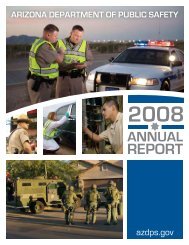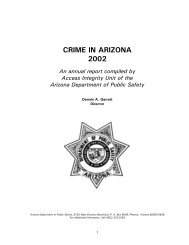2006 DPS Annual Report - Arizona Department of Public Safety
2006 DPS Annual Report - Arizona Department of Public Safety
2006 DPS Annual Report - Arizona Department of Public Safety
You also want an ePaper? Increase the reach of your titles
YUMPU automatically turns print PDFs into web optimized ePapers that Google loves.
Criminal Justice<br />
Support Division<br />
<strong>DPS</strong> develops Court Protection Order Repository (CPOR)<br />
Areas within the Criminal Justice Support Division (CJSD) have been working with the Administrative<br />
Office <strong>of</strong> the Courts (AOC) to automate the exchange <strong>of</strong> order <strong>of</strong> protection/injunction information between<br />
court and law enforcement personnel. The primary objective is to have court personnel complete the<br />
initial data entry for protection orders or injunctions. Once entered, law enforcement personnel have the<br />
ability to review and modify the electronic entry prior to accepting ownership <strong>of</strong> the record. Once accepted,<br />
the record is forwarded to the National Crime Information Center (NCIC) Protection Order File and<br />
to the <strong>Arizona</strong> Court Protection Order Repository housed at the AOC. When protection orders or injunctions<br />
are cleared from the court’s system, nightly transactions provide the owner <strong>of</strong> the record with a<br />
printed message advising the record has been cleared and an electronic message is generated to the NCIC<br />
and <strong>Arizona</strong> files to clear the record from active status. The benefits from this system include the following:<br />
increased protection for the petitioner/victim and law enforcement, more accurate and complete records,<br />
the ability to access these orders faster, promotes cooperation between criminal justice agencies and courts,<br />
and increased statewide integration. As <strong>of</strong> June 30, <strong>2006</strong>, this method is being utilized in Coconino, La<br />
Paz, Gila and Navajo counties.<br />
Scientific Analysis Bureau<br />
<strong>DPS</strong> continues to implement new DNA technology at its elite crime lab<br />
With the introduction <strong>of</strong> Y-STR DNA technology this year, the <strong>DPS</strong> Crime Laboratory is now one <strong>of</strong> only<br />
two or three crime labs nationwide which can bring three different types <strong>of</strong> cutting edge DNA technology<br />
to bear on crime scene evidence to identify or exonerate a suspect.<br />
The three types <strong>of</strong> DNA techniques available are:<br />
• STR DNA analysis (or autosomal DNA analysis) – This is the<br />
traditional DNA analysis used to identify individuals.<br />
• Mitochondrial DNA analysis (mtDNA) – This analyzes the DNA<br />
in the mitochondria <strong>of</strong> the cell which is inherited maternally. This<br />
technique is extremely important for missing person identifications.<br />
• Y-STR DNA analysis – Analyzes the male DNA on the Y-chromosome.<br />
Because Y-STR’s targets only the male DNA, this technique<br />
allows male DNA pr<strong>of</strong>iles to be developed from mixtures with very low levels <strong>of</strong> male DNA<br />
and high levels <strong>of</strong> female. This is particularly valuable in sex assault cases, child molestations, etc.<br />
In addition, the Y-STR DNA technique is twice as sensitive as normal STR’s, allowing DNA pr<strong>of</strong>iles to be<br />
obtained from trace evidence previously unsuitable for DNA.<br />
Already this technique has been used in a number <strong>of</strong> very high-pr<strong>of</strong>ile cases throughout <strong>Arizona</strong>.<br />
89















